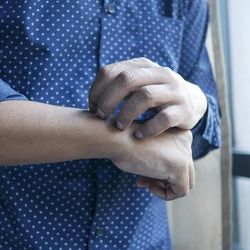
OR WAIT null SECS
Jonathan Silverberg, MD, PhD: Safety Data, Implications of Nemolizumab Findings for Atopic Dermatitis
Another segment of Silverberg’s interview at AAD 2024 featured a discussion on safety data and the larger implications of these phase 3 findings for eczema management.
In this interview with the HCPLive editorial team, Jonathan Silverberg, MD, PhD, director of clinical research for George Washington University’s School of Medicine and Health Sciences, discussed nemolizumab’s safety profile as well as the phase 3 findings’ wider implications for treatment of atopic dermatitis.
This interview followed Silverberg’s team’s recent late-breaking data on nemolizumab’s efficacy at 16 weeks, and they were presented at the 2024 American Academy of Dermatology (AAD) Annual Meeting in San Diego.
After discussing the 2 global phase 3 studies of ARCADIA-1 and ARCADIA-2, both of which evaluated subcutaneous nemolizumab 30 mg administered every 2 weeks, Silverberg described some of the highlights of the studies’ safety data.
“The safety profile observed in this ongoing maintenance period was consistent with what was previously observed,” Silverberg stated. “Overall, pretty clean. Once upon a time there was some initial concern about whether there could be some asthma adverse event. That then didn't really pan out with the nemolizumab readouts for the prurigo nodularis trials or for the atopic dermatitis trials with ARCADIA 1 and ARCADIA 2.”
Silverberg added that if there were any signal there, it would be fairly minimal or negligible. He added that there were no serious infections, malignancies, anything suggesting immunosuppression, or cardiovascular issues.
Later, Silverberg was asked about how he envisions nemolizumab impacting the treatment landscape for patients with moderate-to-severe atopic dermatitis.
“I think we definitely want to see even more secondary analyses to get a better sense of who that nemolizumab patient is, who's the patient who's going to do fantastic on the drug,” he said. “But we did see already, from the initial readouts back in October at the European Academy of Dermatology meeting, that they…already a priori planned to look at the overall population, which had a NRS itch score of 4 or higher. But they also did a subset of patients with an NRS itch score of 7 or higher.”
Silverberg noted the drug had been shown to work quite well in the overall population as well as the severe itch population.
“But for some endpoints, there's a suggestion that it might work even better amongst those patients who have even more severe itch,” he said. “Which, of course, is a pleasant surprise or a pleasant feature, because those are often the toughest patients with the greatest unmet need.”
Silverberg added that his hope is for nemolizumab to be approved in the United States within the calendar year, offering dermatologists a new, safe and effective biologic. He added that the drug is likely to become an important addition to the treatment toolbox to consider for second line systemic or biologic use, perhaps among those who may have already tried dupilumab.
To learn more on these findings, view Silverberg’s full interview segment above.
The quotes contained in this summary were edited for the purposes of clarity.
Related Content:


